Author: Yash Agarwal, researcher at Superteam.fun; Translator: 0xjs@黄金财经
"Let your opponents talk, and they will weave a web that keeps them safe."
Two weeks ago, on "The Chopping Block", Haseeb and Tom from Dragonfly made a series of arguments in the Ethereum and Solana segment. They roughly elaborated on the following:
Solana's VC ecosystem is incomplete.
The amount of funds on Solana is much lower than Ethereum, and there are few winners in the Solana ecosystem except for memecoins.
Solana is seen as a memecoin chain, and perhaps a DePIN chain. Solana's TVL is only $5 billion, which limits its TAM.
Starting a business on Ethereum is like “starting a business” in the US, because the expected value is more positive.
Solana has a higher Gini coefficient (higher inequality).
We’ll review these arguments — highlighting the structural problems of large VC funds and how these problems drive them to make infrastructure investments — and worse, trap founders in bad advice. Finally, we’ll share tactical advice on how to avoid contracting EBOLA (EVM Bags Over Logic Affliction).
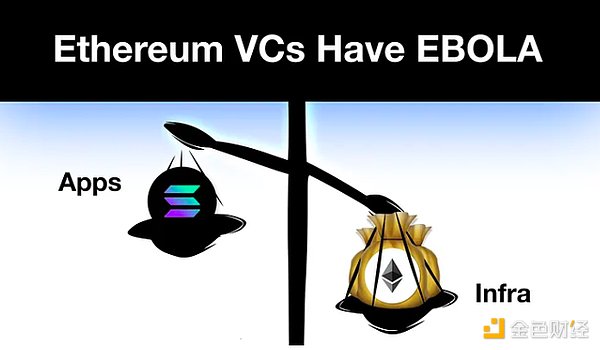
Ethereum VC has highly contagious EBOLA
As Lily Liu of the Solana Foundation said, EBOLA (EVM Bags Over Logic Affliction) is a disease affecting Ethereum venture capital firms-a structural problem, especially for large "tier-one" venture capital firms.
Take a large fund like Dragonfly as an example, which raised $650 million from top LPs such as Tiger Global, KKR, and Sequoia in 2022, and is likely to have proposed an investment theme with a large weight in infrastructure. Large funds like Dragonfly are structurally incentivized to deploy capital over a defined period (e.g., two years). This means that over time they will be willing to fund larger rounds and at higher valuations. If they don’t fund larger rounds, they can’t deploy capital and must return it to their LPs.
Think about the economic incentives of GPs: They get a management fee each year (2% of funds raised) and a success fee on exit (20% of returns). So, on a risk-adjusted basis, funds have an incentive to raise more money to “accumulate fees.”
Given that infrastructure projects (like Rollups/interoperability/re-staking) can easily achieve $1B+ FDV, investing in infrastructure projects is the right thing to do given the billions of dollars of infrastructure exits in 21-22. But this is a narrative of their own creation, driven by the capital and legitimacy engines of Silicon Valley.
Here is what the infrastructure narrative is:
1. The monetary network will succeed the information network. That’s why it’s called Web3.
2. If you could “invest” in TCP/IP or HTTP in the 1990s, you would. Now you can invest through network tokens.
3. These blockchain infrastructure bets are this generation’s bets on monetary protocols that are equivalent to the TCP/IP and HTTP protocols.
It’s a pretty compelling narrative, and there is some substance to this narrative. The question is, in 2024, as we look towards the next EVM L2 specifically designed to scale TPS to support the ultra-high TAM potential of the NFT community, have we strayed from the original story of TCP/IP becoming global currency. Or, is this rationale driven by the fund economics of large crypto funds such as Paradigm/Polychain/a16z crypto.
EBOLA Makes Founders and LPs Sick
Given the assumption that foundational branding drives high valuations, we are seeing many major EVM applications announce or launch L2s in the hope of achieving these high valuations. The chase for EVM infrastructure is so frenetic that even top consumer founders such as Pudgy Penguins feel the need to launch L2s.
Take EigenLayer as an example - a project on Ethereum that has raised $171 million but is far from having any significant impact, let alone generating revenue. It will make some venture capitalists and insiders (who hold 55% of tokens) rich. Criticisms of low circulation, high FDV projects are valid; what about criticisms of low impact, high FDV projects?
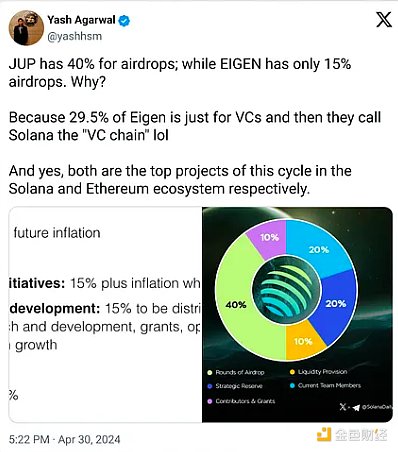
The infrastructure bubble has already started to burst, and many of the top infrastructure projects in this cycle have issued tokens with FDVs below private round valuations. With major unlocks in 6-12 months, VCs will be in a bind, and it will be a race to the bottom to see who sells first, impacting returns.

There is a reason for the new round of anti-VC sentiment among retail investors; they feel that the more VC funds = higher FDV, lower liquidity infrastructure.
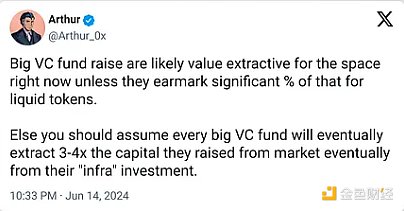
VCBad advice takes you to the grave
EBOLA also claims that among its victims are promising applications/protocols, where venture capitalists influence founders to build applications/protocols on chains that cannot realize their product vision. Many social applications, consumer-facing applications, or high-frequency DeFi applications will never be realized on the Ethereum mainnet because its performance is comparable to that of a modem and gas fees are ridiculously high. Yet, despite alternatives, these applications are still built on Ethereum, leading to a large number of applications that are conceptually promising but cannot go beyond “proof of concept” because the infrastructure they rely on has reached the end of its rope. In my opinion, the examples are numerous, ranging from Enzyme Finance (2017) to more recent SocialFi applications like Friend Tech, Fantasy Top, and Quail Finance (2024).
Take the Lens Protocol from Aave, the largest DeFi protocol, which raised $15 million and launched on Polygon due to a large grant (and is now moving to zkSync again due to another grant) while maintaining its L3. Fragmentation caused by infrastructure chaos led to the downfall of Lens Protocol, which otherwise could have become a foundational social graph. In contrast, Farcaster took an infrastructure-light approach - a Web2-heavy approach.
Recently, Story Protocol received $140 million in funding led by a16z to build an “IP blockchain”. Despite being cornered, Tier 1 VCs are doubling down on infrastructure narratives. As a result, keen observers may notice the exit path: the narrative evolves from “infrastructure” to “application-specific infrastructure” - but often focuses on unproven EVM stacks (such as OP) rather than the proven Cosmos SDK.
Structurally Broken VC Market
The current venture capital market is not efficiently allocating capital. Crypto ventures manage billions of dollars in assets that, in aggregate, need to be deployed to specific tasks in the next 24 months: from private seed rounds to Series A projects.
On the other hand, liquid capital allocators are highly sensitive to global opportunity costs, from “risk-free” treasuries to holding crypto assets. This means that liquid investors will be more pricing efficient than venture investors.
Current Market Structure:
Public Markets – Undersupply of Capital, Oversupply of Quality Projects
Private Markets – Oversupply of Capital, Undersupply of Quality Projects
Undersupply of capital in public markets leads to poor price discovery, as evidenced by this year’s token listings. High FDV issuance is a major issue in the first half of 2024. For example, the total FDV of all tokens issued in the first six months of 2024 is close to $100 billion, half of the total market cap of all tokens ranked in the top 10 to top 100. This is a surefire way to ensure price discovery declines until real buyers are found.
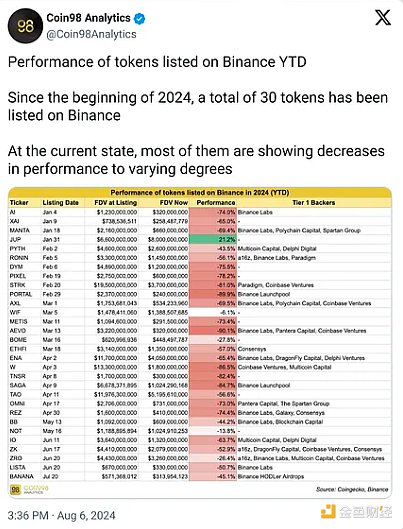
The private VC market has shrunk. Haseeb acknowledges as much – these funds are smaller than the previous ones for a reason – Paradigm would have raised 100% of the size of its previous fund if it could.
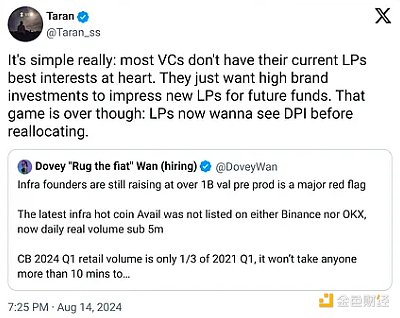 The structurally collapsed VC market is not just a crypto problem.
The structurally collapsed VC market is not just a crypto problem.
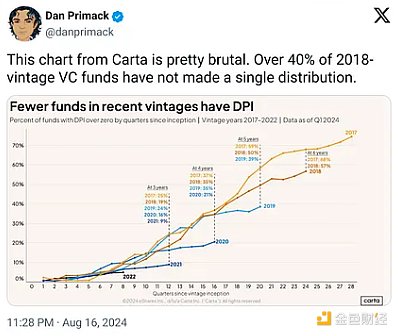
The cryptocurrency market clearly needs more liquidity funds to act as structural buyers in the public market to solve the problem of the VC market collapse.
Vaccination to prevent EBOLA
Enough of the small talk, now let's talk about potential solutions and what we need to do as an industry - both for founders and investors.
For investors - lean towards liquidity strategies and scale by embracing the public market rather than fighting it.
Liquidity funds are essentially investments or holdings in publicly traded liquidity tokens. As Arthur, founder of DeFiance, points out, an efficient and liquid cryptocurrency market requires the presence of active fundamental investors - which means there is plenty of room for cryptocurrency liquidity funds to develop. To be clear, we are specifically talking about "spot" liquidity funds; leveraged liquidity funds (or hedge funds) have performed poorly in the last cycle.
Tushar and Kyle of Multicoin seized on this concept when they founded Multicoin Capital 7 years ago. They believed that liquidity funds could achieve the best of both worlds: venture capital economics (investing in early tokens for excess returns) combined with public market liquidity.
This approach has several advantages, such as:
1. Liquidity in the public market allows them to exit at any time based on changes in their themes or investment strategies.
2. The ability to invest in competing protocols to reduce risk. It’s often easier to spot trends than to pick specific winners within those trends, so liquidity funds can invest in multiple tokens within a particular trend.
While typical VC funds provide more than just capital, liquidity funds can still provide various forms of support. For example, liquidity support can help solve the cold start problem of DeFi protocols, and these liquidity funds can also play a practical role in protocol development by actively participating in governance and providing input on the strategic direction of the protocol or product.
In contrast to Ethereum, Solana’s funding rounds in 2023-24 are on average quite small, with the exception of DePIN; anecdotally, almost all first major rounds are below $5 million. Major investors include Frictionless Capital, 6MV, Multicoin, Anagram, Reciprocal, Foundation Capital, Asymmetric, and Big Brain Holdings, in addition to Colosseum, which hosts the Solana Hackathons and has launched a $60 million fund to support founders building on Solana.
Time for Solana Liquidity Funds:
It’s time to lean into liquidity strategies and make money off of VC incompetence, stupidity, or both. As opposed to 2023, Solana now has a plethora of liquidity tokens in the ecosystem, and one can easily start liquidity funds to bid on these tokens early. For example, on Solana, there are many FDV tokens worth less than $20 million, each with a unique theme, such as MetaDAO, ORE, SEND, and UpRock, to name a few. Solana DEX is now battle-tested, with more trading volume than even Ethereum, and has a vibrant token launchpad and tools, such as Jupiter LFG, Meteora Alpha Vault, Streamflow, Armada, and more.
As the liquidity market on Solana continues to grow, liquidity funds can become a contrarian bet for both individuals (those seeking angel investment) and small institutions. Large institutions should start targeting larger and larger liquidity funds.
For founders — choose an ecosystem with low startup costs until you find a PMF
As Naval Ravikant said, stay small until you find something that works. He said that starting a business is about finding a scalable and repeatable business model. So what you are really doing is looking for, until you find a business model that can be repeated and scaled, you should stay very, very small and very, very cheap to scale.
Solana’s Low Startup Cost
As Tarun Chitra pointed out, Ethereum has a much higher startup cost than Solana. He pointed out that it usually requires a lot of infrastructure development (e.g. the whole application becomes a rollapp craze) in order to get enough novelty and ensure a good valuation. Infrastructure developments inherently require more resources because they are largely research-driven, requiring hiring a research and development team, as well as numerous ecosystem/BD experts to convince a handful of Ethereum applications to integrate.
On the other hand, Applications on Solana don’t need to focus too much on infrastructure, which is taken care of by select Solana infrastructure startups like Helius/Jito/Triton or protocol integrations. In general, applications don’t need a lot of capital to launch; take Uniswap, Pump/fun, and Polymarket as examples.
Pump.fun is a perfect example of Solana’s low transaction fees unlocking the “fat app theory”; a single application, Pump.fun, has surpassed Solana in revenue over the past 30 days, and even surpassed Ethereum in 24-hour revenue for a few days. Pump.fun originally started with Blast and Base, but quickly realized that Solana’s capital velocity is unmatched. As Alon of Pump.fun acknowledged, both Solana and Pump.fun are focused on lowering costs and barriers to entry.

As Mert said, Solana is the best choice for startups because of its community/ecosystem support, scalable infrastructure, and philosophy around delivery. We are already seeing an early trend of new entrepreneurs (especially consumer founders) preferring Solana due to the rise of successful consumer applications such as Pump.fun.
Solana is not just for Memecoin
"Solana is only for memecoins" has been the biggest controversy among ETH maximalists in the past few months. Yes, memecoins dominate Solana's activities, and Pump.fun is at the core of it. Many people may say that DeFi on Solana is dead, and Solana blue chips such as Orca and Solend are not performing well, but the statistics are not the case:
1. Solana's DEX trading volume is comparable to Ethereum, and most of the top 5 trading pairs in Jupiter 7D trading volume are not memecoins. In fact, memecoin activity only accounts for about 25% of DEX volume on Solana (as of August 12), while Pump.fun accounts for 3.5% of daily volume on Solana - a small percentage considering the platform's rapid adoption.
2. Solana's TVL ($4.8 billion) is 10x smaller than Ethereum ($48 billion) as Ethereum still enjoys higher capital leverage with its 5x market cap, deeper penetration of DeFi, and proven protocols. However, this will not limit the TAM of new projects. Two of the best examples are:
Kamino Lend grew to $1.4 billion in just 4 months.
PayPal USD reached $450M supply in just 3 months, surpassing PYUSD’s $360M supply on Ethereum, despite PYUSD having been on Ethereum for a year.
With many EVM blue chips deployed on Solana, TVL is only a matter of time.
While one could argue that the Solana DeFi token’s price has fallen significantly, so have Ethereum’s DeFi blue chips, highlighting a structural problem with governance token value accumulation.
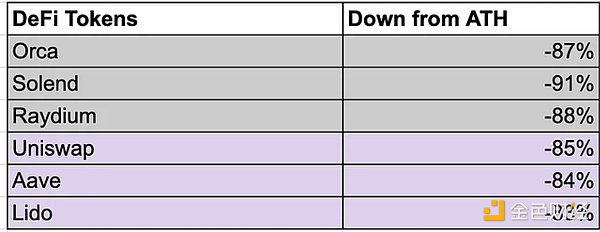
Solana is undoubtedly the leader in the DePIN space, with more than 80% of major DePIN projects built on Solana. We can also conclude that all emerging areas (DePIN, Memecoins, Consumer) are developed on Solana, while Ethereum remains the leader in the space in 2020-21 (Money Markets, Yield Farming).
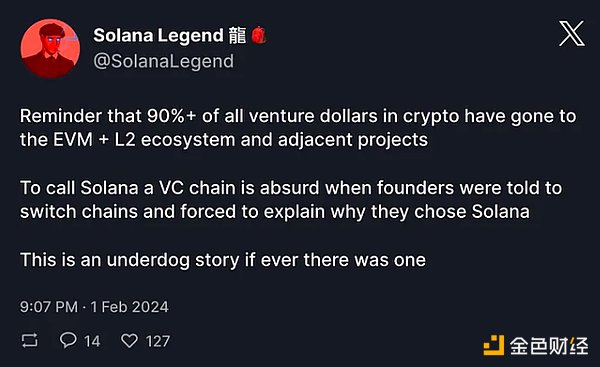
Advice for App Creators
The bigger the fund, the less you should listen to them. They will incentivize you to fund your product before you achieve product-market fit. Uber's Travis does a great job explaining why you shouldn't listen to big VCs. While it's certainly profitable to go after top VCs and high-credibility valuations, you don't necessarily need big VCs to get started. Especially before you're at PMF, this approach can lead to valuation burdens, trapping you in a cycle of needing to constantly raise money and launch at higher FDVs. Poor discovery at launch makes it harder to build a truly distributed community around your project.
1. Fundraising - Smaller. More community-oriented.
Raise money from angel investor groups through platforms like Echo. It’s underrated: you trade valuation for distribution, then play to your strength. Find relevant founders and KOLs, and make a concerted effort to get them on board. This way, you can build an early evangelist community/network of high-quality builders and influencers who can fully support you. Prioritize community over tier 2/3 VCs. Shout out to some of the Solana Angels like Santiago, Nom, Tarun, Joe McCann, Ansem, R89Capital, Mert, and Chad Dev.
Choose accelerators like AllianceDAO (best for consumer projects) or Colosseum (Solana native fund) that are not predatory and are more aligned with your vision. Leverage Superteam for all your startup needs; it’s a cheat sheet.
2. Consumer-oriented — Embrace speculation. Attract attention.
Attention Theory: Jupiter has achieved $8 billion in FDV on the public market, which is a strong proof that the market has begun to value frontends and aggregators. The best part? They are not funded by any VC firms and are still the largest applications in the entire crypto space.
The rise of application-focused VCs: Yes, when VCs see billion-dollar exits, they will most likely follow the same infrastructure strategy to develop consumer applications. We have already seen many applications with annualized revenue of $100 million.
Summary (TLD version):
Stop listening to the forced infrastructure narrative of VCs.
The time has come for liquid funds to flourish.
Built for consumers. Embrace speculation. Chase yield.
Solana is the best place to experiment due to its low startup cost.
 JinseFinance
JinseFinance






 The structurally collapsed VC market is not just a crypto problem.
The structurally collapsed VC market is not just a crypto problem. 





